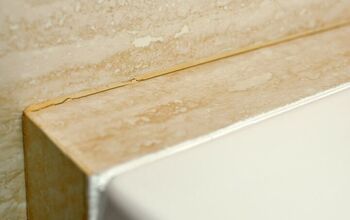What Is Acrylic Grout And What Is It Used For? (Find Out Now!)

When you’re remodeling your bathroom, you’re going to learn a lot about grout. There’s epoxy grout, sanded grout, non-sanded grout, colored grout…the works! Among the different types of grout is acrylic grout. Most of us who don’t make a living in home improvement tend to be a bit confused about what this type of grout is and how it’s used. Are you curious about acrylic grout, too?
Acrylic grout is an unsanded grout that’s made of a mixture of latex with an acrylic additive. It is a grout type that is meant to be gentle on tiling. Unlike many types of grout, acrylic grout has a certain level of flexibility that makes it great for areas that need joining that can move a little.
Getting the right grout is one of the best ways to make sure that your remodeling project goes well from the get-go and also stays good for years to come. Let’s talk about this type of grout before you hit the home improvement store.
Do You Need Grout Replacement or Repair?
Get free, zero-commitment quotes from pro contractors near you.

What Is Acrylic Grout?
Acrylic grout is a bit of a misnomer. This is a type of grout that is primarily made from latex or silicone. Like other grouts made from latex and silicone, it’s an unsanded type of grout. The only difference between acrylic grout and latex grout is that it has an additive that adds acrylic-based polymers to the mix.
What Is Acrylic Grout Used For?
Acrylic grout is one of the more niche types of grout on the market, and honestly, it’s used for a very select type of job. Acrylic grout is best for sensitive, delicate types of tiling like marble or ceramic. The acrylic polymer additive makes the grout more water-resistant and also helps improve the flexibility of the grout itself.
What Kinds Of Projects Tend To Do Well With Acrylic Grout?
A good rule of thumb is that you can use acrylic grout in almost any situation that you would want to use epoxy grout. So, bathrooms, pool rooms, and spa houses all are great places to use it. The best way to think of this grout is to assume that it’s best for super thin spacing in areas where epoxy would usually be popular.
Because acrylic grout is made for sensitive tiles in wet areas, this tends to be a good choice for projects that are in high-traffic areas that involve water. So, commercial venues like spas, banyas, public bathrooms, and hotel pool rooms all tend to do well with this type of grout. This is particularly good for elegant ceramic tiles that are prone to chipping or scratches.
How Is Acrylic Grout Made?
Acrylic grout is basically like regular latex (or silicone) grout with one exception. In the part of the creation process that involves adding water to the mixture, acrylic additive replaces the water. This is what makes the grout more flexible. Many companies that sell their own acrylic-hybrid grouts will do this on their own, and also add a couple of other additives.
If you want to make your own, you can. Several companies sell acrylic additives on their own. As long as you follow the additive instructions, you should be able to turn your regular old latex grout into acrylic grout.
How Does Acrylic Grout Handle Temperature Changes?
One of the most common reasons why people tend to reach for acrylic grout is because it is great for conditions that tend to require a lot of temperature changes. More specifically, it’s good for places where you might have a lot of freeze/thaw or extreme heat. A lot of acrylic grout’s versatility is due to the flexibility it offers in grouting.
Traditional grout will crack when it’s exposed to extreme temperatures in a short amount of time. It’s just too rigid to go through too many freeze/thaw cycles. Acrylic lets the grout expand and contract without causing a major crack. It works with the natural shifts that happen.
How Much Does Acrylic Grout Cost?
Since it is a pretty niche, “extra” type of grout, you should expect to pay a little bit more than what you would for regular latex or silicone grout. Most premixed acrylic grout tubs will cost between $50 to $90 per tub, making it one of the more expensive types of grout to buy premade.
Want to save some cash by getting the additive alone? Well, it’s not going to be much cheaper since you have to buy the acrylic and the base grout, too. The additive itself can run between $10 to $20 per container, and silicone grout can easily cost an additional $40 or so. As a result, it’s often just more convenient to buy the premixed stuff. Besides, it’s less of a chance of having a mixing error.
Where Can You Buy Acrylic Grout?
Acrylic grout may be niche, but it’s not rare. While it is not as common to see as regular epoxy, it’s still fairly common. You can buy acrylic grout at any Lowe’s, Home Depot, or Ace Hardware store. If you want to go to an online retailer instead, it’s good to know that Amazon and many “small box” e-tailers will be able to help you out.
Can You Buy Colored Acrylic Grout?
In the past, one of the most common reasons why acrylic grout would get passed up by home designers deals with the way that it was sold. It used to be exclusively available in white. Thankfully, you no longer have to trade flexibility in grout for flexibility in color. It’s possible to find tinted or colored acrylic grout at most big box hardware stores.
The majority of the colors that acrylic grout comes in (for premixed versions, anyway) are greys, creams, or beiges. If you want to get a more exotic color like forest green or brick red, then you are going to have to mix your own color additive into it. With that said, we do not suggest trying to do that with just any type of additive. Read the instructions before you start mixing. Not all dyes work well with acrylic!
Do You Need Grout Replacement or Repair?
Get free, zero-commitment quotes from pro contractors near you.

Related Questions
Can using an acrylic grout additive help protect your floor against mildew?
Grout often needs a little help when it comes to protection from water damage and mold. Using additives in your grout instead of water can help shield the grout from mildew and molds. The best additives to use are ones that are graded for waterproofing, such as acrylic additives. If you want to get further protection from the elements, look for a high-performance sealer too.
How long does grout last?
This depends on the grout, but it’s worth noting that some grouts have a far longer shelf life than others. Powdered grout will only last a year before it’s no longer usable. On the other hand, sealed epoxy grouts that have never been opened can sit on a shelf indefinitely as long as the storage conditions are decent. Additives have a shelf life that can vary greatly.Some last for six months to a year, while others can be indefinite. Most grouts will have a special instruction set that will help you determine how to best store it. If you notice that your grout looks very lumpy or has a strange consistency, toss it out. It’s probably gone bad.
Can you use caulk in place of grout?
While it may seem like a good idea at the start, the truth is that caulk is no substitute for grout. The two tools have very different purposes. Caulk often needs short-term touch-ups, while grout is meant to be a more long-term tool. If you try to use caulk instead of grout, your tiling project will eventually fall apart at the seams.Grout might not be the most entertaining thing on the planet, but it is a must-have for almost any project.
Related Articles

Ossiana Tepfenhart is an expert writer, focusing on interior design and general home tips. Writing is her life, and it's what she does best. Her interests include art and real estate investments.
More by Ossiana Tepfenhart

















![How To Reset A Whirlpool Cabrio Washer [In 5 Easy Steps!]](https://cdn-fastly.upgradedhome.com/media/2023/07/31/9076531/how-to-reset-a-whirlpool-cabrio-washer-in-5-easy-steps.jpg?size=350x220)







![Standard Dining Room Table Dimensions [for 4, 6, 8, 10 and 12 People]](https://cdn-fastly.upgradedhome.com/media/2023/07/31/9074335/standard-dining-room-table-dimensions-for-4-6-8-10-and-12-people.jpg?size=350x220)

